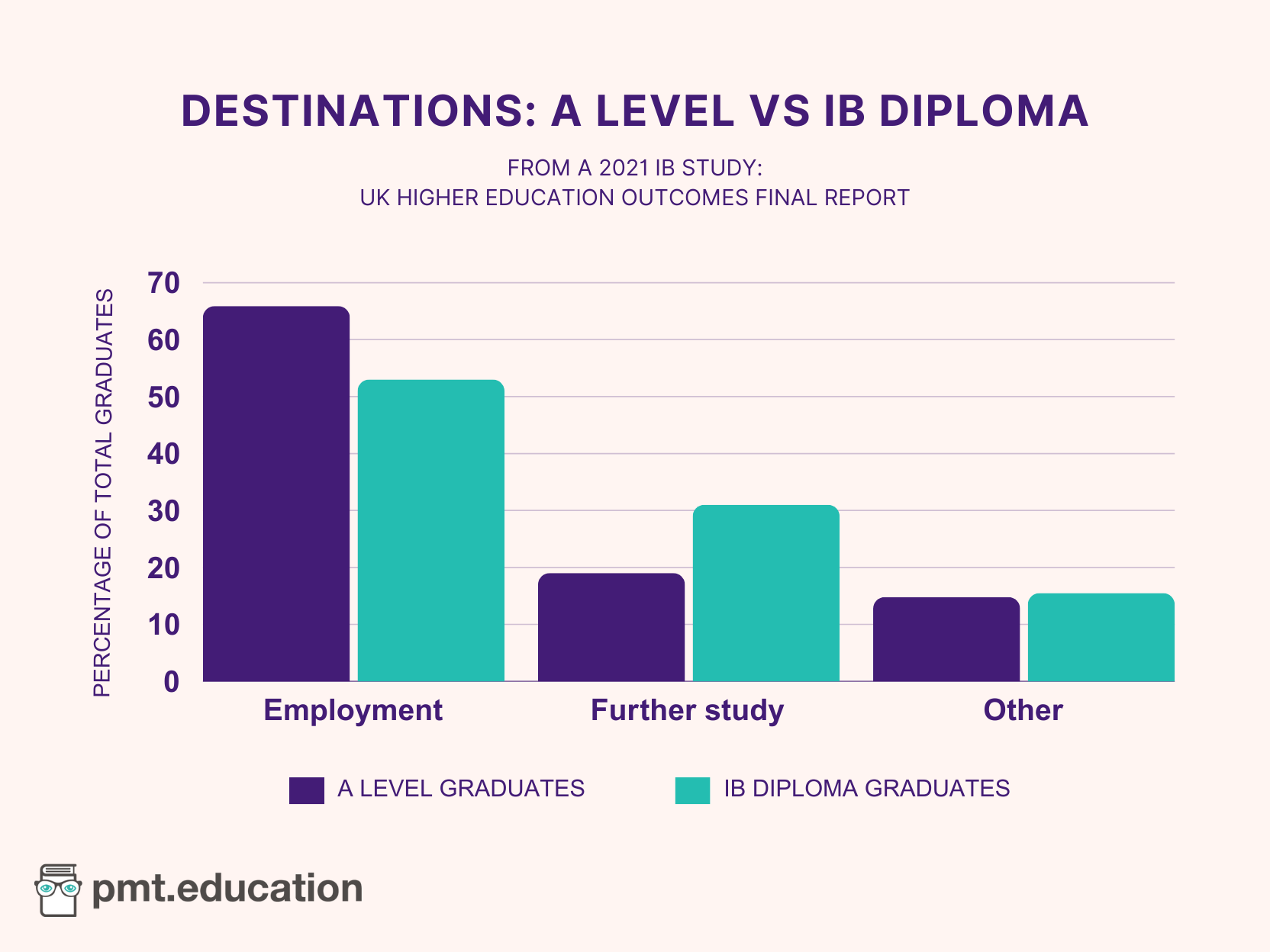Contents:
The International Baccalaureate (IB) Diploma Programme (DP) and A Levels are both highly respected qualifications for students in their final two years of secondary education. Both are ideal for students interested in studying academic subjects that can lead to higher education in STEM fields. This article will discuss the key factors to consider when choosing between the IB DP and A Levels.
IB vs A Levels: What are the key differences?
Curriculum
Both the IB DP and A Levels consist of subject courses. The subject courses are taught over a two-year period and involve content learning and practical demonstration.
The IB DP has an additional DP Core, which comprises three mandatory sections:
- Theory of Knowledge (TOK): An extended written project, encouraging you to question the basis of your knowledge and develop your critical thinking skills
- Creativity, activity, service (CAS): Students take extracurricular activities and a voluntary community service project
- The extended essay: A 4000-word extended written project surrounding an in-depth, self-directed piece of research on a topic of your choice
A Level curricula vary with subject and exam board, whilst the IB DP has one curriculum for each DP subject. Additionally, the IB DP can be taken at a Standard Level (SL) or Higher Level (HL), whilst A Levels are restricted to one level for all students.

Number of subjects
The IB DP requires students to study a wide range of subjects across different disciplines, including languages, sciences, mathematics, and humanities, ensuring both breadth and depth of knowledge. This gives IB DP students less freedom over their subject choices, whilst A Level students are free to choose any combination of subjects they like. As a result, only A Level students are able to take entirely STEM subjects.
IB DP students select six subjects from six predetermined categories, with three to four at HL and the rest at SL. In comparison, A Level students typically take three to four subjects over a two-year period, although up to 5 subjects are permitted.
Finally, the IB and A Level curriculums differ in the number of subject options available to students. There are 34 different subjects available in the IB DP and around 80 available at A Level, giving A Level students greater flexibility. Note that the subjects on offer will vary across schools and colleges.
Method of assessment
The way in which A Levels and the IB DP are assessed are similar. However, the IB DP includes two compulsory essays that contribute to your final grade.
Typically, the IB DP and A Levels assess STEM subject courses using examinations which are sat at the end of the two-year course and marked externally. Practical elements are assessed using required practicals conducted in school and accompanied by a written laboratory report; these are awarded a pass or fail internally by the teacher.
Non-STEM subject examinations are subject-dependent (e.g. drama is assessed internally by performance). The DP Core is assessed using separate examinations to the subject courses, with extended essays marked externally and extracurricular activities given internal authentication of participation.
Grading system
The IB DP grades subjects on a scale from 1-7 for each subject component and 1-3 for the entire DP Core. Overall, students can gain a maximum score of 45. Your final grade depends on overall performance across each subject and requires you to pass the DP Core. This is unlike A Levels, for which each subject is awarded a stand-alone grade from A*-E, with U representing a fail.
The IB DP is graded using an international system against a set standard mark, whilst A Levels are graded by ranking students within their cohort using a statistical distribution.

Summary
DP core components: Extended essay, TOK, CAS
80 subjects to choose from (availability varies between schools)
Practical elements for STEM subjects marked internally and require a pass
Extended essay and TOK within DP core and written work, graded together from 1-3
CAS requires authentication of participation
Practical elements for STEM subjects marked internally and require a pass
Pros and cons
There is no correct answer to which qualification is objectively better or harder. Both have challenging aspects and both have their pros and cons.
Pros and cons of the IB DP
| Pros | Cons |
|---|---|
| Broader learning experience: By taking a variety of subjects, you gain a wider knowledge base | Subject restrictions: You might need certain subjects that are outside your personal interests and expertise |
| Tailored difficulty: The program offers both standard and higher levels, catering to a wide range of academic abilities | Limited STEM specialisation: You cannot focus solely on STEM subjects as you are required to choose subjects from predetermined categories |
| Global recognition: Easier pathway to international education or career opportunities | Availability: The programme is less commonly offered across UK schools |
| Core components expand knowledge: TOK, CAS and the extended esssay ensure well-rounded academic skills, preparing you for further education | Core requirements: To successfully pass the program, you must complete and pass the core coponents |
| UK university recognition: Accepted and valued by all UK universities | Subject load: Managing multiple subjects at the same time can be challenging for some students |
Pros and cons of A Levels
| Pros | Cons |
|---|---|
| Full control over subjects: You have the freedom to focus on the areas you’re passionate about | Limited subjects: With only 3 or 4 subjects, some students may feel restricted in their choices |
| Wide range of subjects: More options to choose from than many other academic programmes | Challenging for the undecided: It can be tough to make decisions if you’re unsure of your future direction |
| Encourages independence: The flexible nature of A Levels promotes self-directed learning and decision-making | Heavy self-study: The greater emphasis on independent learning isn’t suited to all students |
| Well-supported system: A Levels are widely available in the UK, with strong resources and guidance in most schools | Continuation from GCSEs: A Levels build on previous GCSE knowledge, which may be difficult for those who have followed a different path |
| UK university recognition: Accepted and valued by all UK universities | No core additions: No compulsory projects or voluntary work, potentially resulting in missed opportunities for personal growth |
IB vs A Levels: Graduate outcomes
No matter where your next steps in STEM lead you – whether to university, vocational qualifications, or starting a job – both the IB DP and A Levels provide distinct benefits. The following summary of studies comparing the pathways taken by past graduates can help you determine which qualification is typically chosen by students with similar goals to you.
University
IB DP students: Having practised university-style coursework through extended essays and developed critical thinking and research techniques, IB DP graduates often feel well-prepared for university. Universities have reported looking for extracurricular activities in applications, which IB DP students are awarded for but A Level students must pursue independently. The acceptance rate to top universities is three times higher for IB students, especially internationally. However, this may be reflective of the fact that the IB is mostly taught in private schools, whose students are proportionally overrepresented at universities across England.
A Level students: A Levels are highly regarded by UK universities and are particularly beneficial for students pursuing STEM subjects, as these courses often emphasise a deeper understanding of specific subject areas. The focus on specialised knowledge and independent learning not only aligns with the demands of university-level study but also helps students excel in their chosen fields. However, A Levels may be viewed as less favourable compared with the IB DP when applying to universities abroad.
Vocational qualifications
IB DP students: IB DP graduates entering vocational qualifications have benefited from their experience in applying subject knowledge to the real-world CAS community service project. Vocational education programmes are often assessed using methods that mirror the DP core’s TOK; they require students to reflect on their own knowledge, which IB DP students are therefore more practised in.
A Level students: As with university suitability, A Level graduates are well-suited for specialised vocational pathways due to their focused study on specific subjects. However, the lack of compulsory broader skill development may be a disadvantage.

Vocational qualifications include:
- Business and Technology Education Council qualifications (BTECs)
- National Vocational Qualifications (NVQs)
- T Levels
- Apprenticeships
Careers in STEM
IB students: Thanks to the value of intercultural understanding and multilingualism upheld throughout their education, IB graduates are often perceived as more adaptable and better prepared for the multicultural workforce. These aspects can also make the IB DP preferable for application to multinational companies. Furthermore, the broad skill set and critical thinking abilities encouraged through the DP core are valued by employers.
A Level students: The benefit A Level graduates have in fields requiring specialised knowledge extends into the professional world. They are highly desired for specialised roles due to their expertise in specific subjects and their experience with independent learning. However, A Level graduates more often require additional practical training, either before entering the workforce or once employed.
Student destinations data
The following graph compares the graduate outcomes of A Level students and IB students, highlighting differences in their post-secondary achievements. The data is from the 2021 IB study on higher education outcomes in the UK.

The data reveals that both A Level and IB DP students predominantly enter the workforce after graduation. However, a notable difference is observed in the proportions: a higher percentage of A Level students move directly into employment compared to their IB DP counterparts. Conversely, IB DP students are more likely to pursue further studies than A Level students. This could, however, reflect the nature of the students rather than the course, with UK IB students more likely to be international or from private schools. The proportion of students in other categories, such as gap years or self-employment, remains relatively consistent between the two groups.
Keep in mind
Both qualifications leave you eligible to apply to university and employment opportunities in the UK. You won’t be closing any doors by choosing one over the other.
Both the International Baccalaureate Diploma Programme (IB DP) and A Levels offer distinct advantages and cater to different student needs and preferences. The IB DP’s broad, interdisciplinary approach and emphasis on critical thinking prepare students well for a range of future paths, including international opportunities. On the other hand, A Levels provide focused specialisation, particularly beneficial for students with a clear direction in STEM fields.
Next in the guide, we’ll explore the IB Career-related Programme (IB CP), which combines academic study with practical career-related learning, offering an alternative route for students interested in blending education with professional development.
FAQs
What is the main difference between the IB and A Levels?
The International Baccalaureate Diploma Programme (IB DP) allows you to gain a wider breadth of knowledge across more subjects and be awarded for extracurricular and written activities through the DP’s core element. In contrast, A Levels encourage a deeper understanding of fewer subjects and allow greater flexibility over subject choices.
Do UK universities prefer the IB vs A Levels?
A Levels and the International Baccalaureate Diploma Programme (IB DP) are recognised and accepted by all UK universities. On the whole, there is no declared preference between the two by UK universities; they appreciate the unique strengths of both A-Levels and IB qualifications.
However, studies by the IB found enrolment at a Top 20 higher education provider was significantly more likely for IB diploma students than A Level students.
How do international universities view the IB vs A Levels?
If you plan to study internationally, more universities will recognise the International Baccalaureate Diploma Programme (IB DP). This is because it is studied worldwide and has an internationally standardised grading system that can be understood across the world. A Levels are British qualifications, which are transferable abroad but can create complications:
- Different grading systems are hard to convert between
- Other countries don’t specialise as early, so look for breadth of knowledge for embarking on university degrees
Taking international A Levels or the IB can solve this problem.
Is the IB harder than A Levels?
The difficulty of different qualifications is relative to your personal strengths and preferred learning methods. Some students thrive in practical applications of knowledge, while others excel in timed examinations. Although the percentage of students achieving the top grade in A Levels is higher compared to the International Baccalaureate Diploma Programme (IB DP), which might suggest that the IB DP is more challenging, the UCAS points system reveals that an A* in A Levels and a Grade 7 in Higher Level IB both equate to the same number of UCAS points. This should indicate that neither qualification is inherently harder or more valuable than the other.
Can you mix IB and A Level courses?
Students are technically allowed to take a mix of International Baccalaureate Diploma Programme (IB DP) and A Level courses, but schools rarely offer this option. The IB DP requires the completion of all its components to earn the qualification, and adding A Level courses could create an unmanageable workload, potentially leading to poorer overall results.
While combining A Levels with the IB DP might broaden a student’s subject range, it often offers no additional advantage when applying for next steps. Most students find that the six subjects included in the IB DP, along with its skill-focused core section, are sufficient to meet their academic and personal interests.



Comments